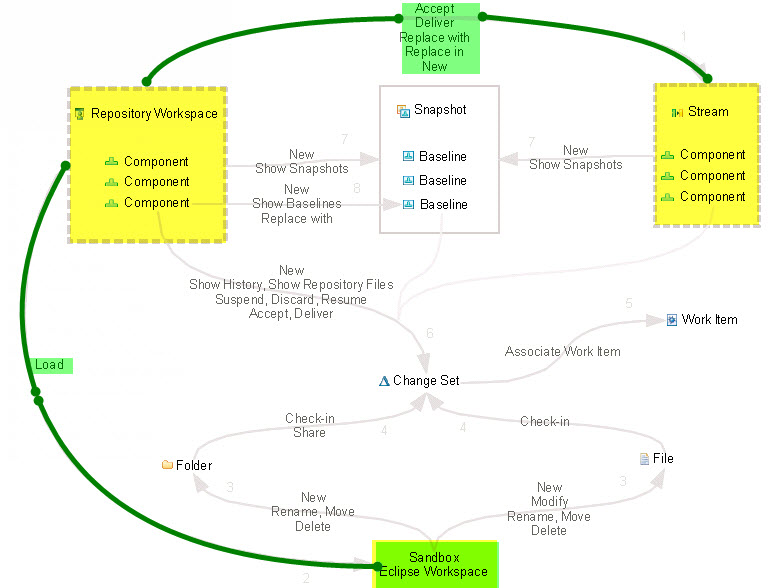How to start using RTC SCM for Dummies
2 answers
https://jazz.net/products/rational-team-concert/features/clients#shell
You're not developing in Eclipse or Visual Studio so the examples you've been looking at haven't described how to share content that isn't an Eclipse or Visual Studio project. You could also use the command line if you prefer but I think the Windows Shell client would suit you well.
Once you get your content shared, you can continue with your development and use the Windows Shell client to perform your SCM operations.
Comments
I installed the Windows Shell Client and it looks like it can be useful. BUT:
Sorry, I didn't realize the limits of the Windows Shell client. It doesn't seem to support creating streams but you can certainly open a work item enhancement to get this feature.
You can use your Eclipse client to configure your streams, process, and permissions. Then your everyday work with source control can be done with the Windows Shell. Ignore loading and dealing with sandboxes using the Eclipse client. You'll use it for administration only.
For flow diagrams, you'll have to use the Eclipse client. I don't think you'll need to use this regularly though. It might help to visualize where you intend to flow your changes but I think most developers won't need this.
you mention you've parsed Jazz.net forum for a while.
Did you check the following parts of the InfoCenter ?
- Organizing projects into components and streams:
http://pic.dhe.ibm.com/infocenter/clmhelp/v4r0m1/index.jsp?topic=/com.ibm.team.scm.doc/topics/t_scm_eclipse_components_streams.html
-> Explains: how to create streams and components
- Lesson 6: Managing source code
http://pic.dhe.ibm.com/infocenter/clmhelp/v4r0m1/index.jsp?topic=/com.ibm.team.concert.tutorial.doc/topics/tut_rtc_scm.html
-> Explains : how to
Create a Repository Workspace
Author code
Put your code under Jazz Source Control
Deliver your changes to your team
- Lesson 7: Building with Jazz Team Build
http://pic.dhe.ibm.com/infocenter/clmhelp/v4r0m1/index.jsp?topic=%2Fcom.ibm.team.concert.tutorial.doc%2Ftopics%2Ftut_rtc_build.html
-> Explains : how to set up your build environment
I believe these ones could bring you some good insights wrt what you're trying to accomplish.
Hope this helps.
Regards,
Stéphane
Comments
Hi Stéphane,
Hi Duzgun,
to get familiar with the Jazz SCM basics, I'd suggest you have a look at the Jazz Source Control FAQ .
Among other interesting stuffs, it provides a "A picture [..] (worthing) a thousand words" which I reproduce below - with some highlighting I've added to make particularly clear the relationships between stream, repository workspace and sandbox.

Hopefully you should now get a better understanding how these things articulate ?
Regards,
Stéphane
Comments
Duzgun Aral
Feb 20 '13, 6:34 p.m.If you don't have time to answer the whole workflow, you can just start with one step, someone else can continue from there and so on...
Geoffrey Clemm
FORUM ADMINISTRATOR / FORUM MODERATOR / JAZZ DEVELOPER Feb 20 '13, 8:40 p.m.The details of the guidance for putting your files under source control will depend on what RTC-SCM client you want to use to do so. In particular, do you want to use the Eclipse client, the Visual Studio client, the scm command line, or the Windows Explorer (you could also use the Web Browser client, but that is more for document management scenarios where you are just accessing one file at a time). Or would you like us to suggest which client to use? (My favorite is the Eclipse client, for example).
Duzgun Aral
Feb 21 '13, 10:20 a.m.I'm in an environment where I have all clients. But for this example I will be using the Eclipse client.
Duzgun Aral
Feb 21 '13, 4:57 p.m.After another day, I finally was able to add files to my component by "loading" my component to my sandbox (which I thought would be the same one that the shell client uses, but it is not, more confusion) . Then I copied files into the local folder but they never showed up in Pending changes. Then I notice the tiny little down arrow where I can actually select "Refresh Sandbox" and the file magically appeared. I checked them in and delivered them. I guess it is delivered to Version 1 Stream now.